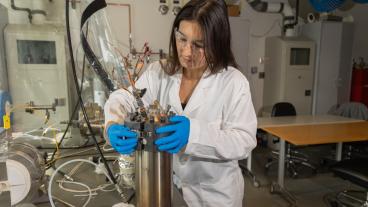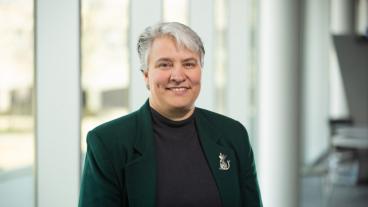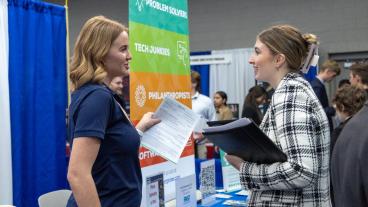Geophysical engineering student Austin Bistline details his experiences during the two-week Geophysics Field Camp in Pagosa Springs, CO.
Monday, May 12
Today we gathered at Mines campus to leave for Pagosa Springs, CO. It was snowing quite heavily so we delayed our departure until 11 a.m., which allowed for a short geology lesson. Dr. Robert Raynolds (Dr. Bob) of the Denver Museum of Nature and Science quickly outlined the geology along our route to Pagosa. Once underway, Dr. Bob and others pointed out the geology and interesting landmarks. Everyone arrived in Pagosa Springs shortly after 5 p.m.
Tuesday, May 13
The group was presented a broad overview of the regional and local geology and an attempt was made by our instructors to outline the problem at hand—understanding the subsurface plumbing that causes the geothermal anomalies in Pagosa Springs. We were also shown a small portion of the geothermal heating infrastructure of the Town of Pagosa Springs to gain an understanding as to how people can benefit from the geothermal resources. The entire group of students were together today, guided by Dr. Bob and Dr. Michael Batzle. We studied through fresh morning snow, heavy snowfall in the afternoon, and freezing temperatures, finishing around 5 p.m.
Wednesday, May 14
Today was about gathering geological information in the Chromo valley, to create a rough idea of the subsurface geology and geothermal fluid flow in the locale of Chromo where we will be collecting our geophysical data to reinforce or correct our initial geological inferences. Cross-sections were created using collected strike and dip, as well as oil-well data from the Colorado Oil and Gas Commission. The entire crew of students were together today, guided by Dr. Bob, Dr. Batzle, and a local, Marvin Johnson, who happens to be an expert in seismic acquisition/interpretation and a Mines alumni. Marvin was gracious enough to work with us from 7 a.m. until 10 p.m., when we finished our rough geological cross-sections. The weather was sunny and cool today.
Thursday, May 15
We began the process of gathering geophysical data today, after a short discussion with Dr. Bob about our geological cross sections that we created the day before for the Chromo anticline. The data collection process for the next seven days was outlined and we were assigned to one of 10 geophysical methods to help perform for the day. I was assigned to DC Resistivity (which measures apparent resistivity in the subsurface) with Dr. Andre Revil and four other students. Dr. Batzle decided to tag along with us as well because he had never been on the DC Resistivity crew before and he ended up placing most of our flags, marking 20 meter spacing between electrodes. DC resistivity should tell us something about fluid type and location in the subsurface as well as prominent geological features such as shale/sandstone contacts as well as faulting, but it is important to note that it is a very low-resolution method.
The goal is for all of the students to assist in each geophysical method for a day, gaining equal exposure to all, so I should be able to report on a different method each day. The weather is sunny but cool today in Chromo– very nice weather to begin collecting data.
Friday, May 16
Today I was on the seismic crew placing geophones—jug-hustling they call it. We were able to place about 1.5 km worth of geophones, six per ten meter spacing, so around 900 geophones were stomped into the ground. The work wasn’t hard, but there were a lot of curse words flying around due to the endless fiasco of tangled wires that we had to unwind—tedious to say the least. At one point, one of the locals driving by stopped to let us know he had a generator we could borrow so we didn’t have to string out so much extension cord. We had a good laugh. The crew from CGG was working on the Vibroseis trucks and had the engines revved up for about two hours. At one point, they drove one of them out on the road close to where we were laying out geophones, and tested the frequency sweep of the system. We could feel the Rayleigh waves traveling through the surface and some of us thought that was pretty cool! I’ll be excited when we see the seismic data come into fruition and figure out the structure of the Chromo Anticline.
Around noon, a report came in that a bear had been sighted north of the Navajo River across from the fire station, which wasn’t too far from where we were. We all tried to locate it from the road to no avail, and finally decided that the EM crew that spotted it had made the whole thing up. The weather was great again today, nice and sunny, not too hot and not too cool.
Saturday, May 17
Today was interesting because I was the crew boss for the Magnetotellurics (MT) and Ground-penetrating radar (GPR) methods. It was my responsibility to make sure all equipment we used was accounted for; that everyone in my crew had what they needed, stayed safe and worked effectively. Everyone gets the chance at some point to be crew boss. MT requires a large 100 by 100 meter space, so we had to set it up in some of the lots north of County Road 392. We quickly realized that the fields were jam-packed with spiders and snakes—so that was interesting. We had another report of a bear, this time with two cubs, passing close to one of the crews to the east down the line.
The GPR method consists of dragging a small plastic box backwards down the road 20 meters at a time. Usually one person is dragging and another is walking and taking notes, so it’s not too bad if the other person is a good conversationalist. We have really been spoiled with the weather pretty much every day that we’ve been collecting data. Nice and warm today, sunny and warm in the morning, cloudy and a few raindrops in the afternoon.
Sunday, May 18
I was assigned to the Electromagnetic method today. This procedure is done with the instrument known as the EM47. We actually got more done today than any other crew has doing this method nine stations total—and we had a lot of fun while doing it. I’m not sure if we are getting sillier because we are delirious from working seven long days straight, but everyone is definitely more laid back and having fun. We all had transceivers and our own channel to communicate, so it wasn’t long before we had radio humor happening, warning the others to not “feed the wild professors” seen on the road nearby, and other silly quips that got everyone laughing.
On a more serious note, we did see three bears today—all of them cubs. Two were small enough they could have been easily mistaken for small dogs. The small ones were hanging out on a branch in a tree just east of the Chromo fire station. The other probably weighed 90 lbs and was seen running across the road across the field from where we were conducting our EM survey first thing in the morning. As a camp, we’ve seen bears nearly every day since we started doing our geophysical surveys so we have been exercising caution, eating together at the fire station, etc. According to the locals, there are thousands of them in the Chromo valley and we shouldn’t be at all surprised to see them.
Monday, May 19
Today I repeated the seismic method, but it was much more interesting than it was on the previous Friday. Instead of stomping geophones in the ground, I controlled the Vibroseis truck or ‘Vibe’ from the ‘doghouse’—the enclosure that houses all of the seismic recording and acquisition parameters. All was well and we were recording our first four sweeps (which is essentially just the Vibe shaking the ground from low to high frequencies) when the GPS antenna fell off the doghouse, ruining the timing. From then on, the doghouse was unable to start the Vibe and we spent two hours troubleshooting the problem. I left during this time to put in my time surveying the last few points on the DC Resistivity line. After that, I helped the rest of the seismic crew pull up geophones and wind up cables to get ready and progress the seismic line to the east.
At the behest of our professors, we began a ‘student site’ to the south of our main survey area located at the Crawley Ranch. We had chosen this area due to the existence of an oil well drilled in the 1930s that now had geothermal water flowing from it and we thought we might get some additional information about the Chromo Anticline by conducting geophysical surveys close to the well. I was dismayed to find that some of the other students had laid out an elaborate survey grid in a direction opposite to what I had pictured. After some heated debate and input from Dr. Richard Krahenbuhl, we decided that in the interest of time, we would simply change the target of our investigation from the subsurface geology to the old oil well in order to keep the survey grid. Fun stuff.
Tuesday, May 20
We really knocked it out of the park at the student site today. Our original intent was to conduct a DC Resistivity survey, five lines, 315 meters long, over the student site. Due to hammer seismic operations at the student site, we were forced to cut the length of our DC survey in half, and by doing so, we were able to not only run five lines in a northwest/southeast direction, 25 meters apart, but we were able to run five lines in the northeast/southwest direction, 40 meters apart, attaining a true 3D DC survey. The inversion should be fantastic!
Four other students and myself gave a short presentation to a group of local kids this evening, explaining who we are, what geophysics is about and what we are doing here in Pagosa Springs. We demonstrated several geophysical methods that we use. They really got a kick out of the demonstrations. One of the girls caught me off guard when she asked me if Santa Claus was real, then gasped when I returned a quick “Nope!” Maybe I should have told her that none of our geophysics experiments have shown evidence of his existence. All in a day’s work.
Wednesday, May 21
There has been a cold floating around the camp and it manifested itself in me quite heavily today. We were still able to get a full magnetic survey at the student site and a small 30 meter by 30 meter EM31 survey done directly over the old oil well that we are interested in, but I was definitely dragging my feet due to a loss of energy. I think several of the students have had this at some point and it makes me appreciate that we are all able to continue toeing the line.
Today was the last day for collecting data—or at least it was supposed to be. One of our professors is determined to collect a 1.26-kilometer line of DC resistivity at the student site, something that I have been advocating for along with several others. We just thought we wouldn’t have time now, but our professor is making it happen. By contrast, the seismic survey on the main line looks like it will be cut short by two-thirds, which greatly disappoints many of us students. Seismic data is the most informative for the subsurface geology, but the company that is performing the survey (and educating us in the process) has had a myriad of problems and setbacks and we are simply out of time. We are grateful for the data that they did collect though and are excited to process it back at Mines next week.
Thursday, May 22
Today was ‘breakdown’ day. Most of the students went south to Chromo to pick up all of the geophones and seismic line as well as finish the electromagnetic EM47 survey at the student site. Ten of us stayed behind in Pagosa Springs. Four of us, including myself, stayed to participate in hammer seismic while demonstrating two other geophysical methods (magnetics and GPR) to high school students. The other six stayed behind to assemble a preliminary presentation, presented in the evening, for anyone interested in listening to what we had found during these last two weeks. The high school students were a no-show unfortunately, but we still collected some hammer seismic data, and then proceeded to pack all of the equipment and supplies into the U-Haul truck for the trip home on Friday. Everyone showed up around 1:30 p.m. with all of the remaining equipment from Chromo and we finished packing by 3 p.m. and headed back to the hotel.
This evening we all arrived back at our headquarters to listen to the six students give their presentation. Several of the local Pagosa Springs residents showed up as well, much to everyone’s delight, and some even had some pretty tough questions that took several tries to answer – somewhat successfully I’d say. All in all, the presentation was great and I thought we were represented well. Afterwards we all participated in a customary bonfire back at the hotel, roasting hot dogs and marshmallows, to signify our last night in Pagosa Springs. It has certainly been a long two weeks and I am very proud of my class and all that we have been able to accomplish!
Friday, May 23
We all were able to sleep in for 45 minutes this morning, throwing our duffel bags into the U-Haul and leaving by 8 a.m. It was an uneventful ride home back to Mines, but I’m sure I wasn’t the only one examining the rock outcrops along the way and pondering their physical properties and thinking about better ways to image them, using geophysics, when they are far below the surface. Colorado is certainly a prime area to test future hypotheses and I’m excited to be acquiring the background that it takes to be a relevant future geophysicist. In the meantime, we will be re-assembling next week to begin the final processing of our data and construct the report and final presentation of the geological structure in Chromo, for which I’m sure we are all excited and honored to participate in!
Contact:
Kathleen Morton, Communications Coordinator / 303-273-3088 / KMorton@mines.edu
Karen Gilbert, Director of Public Relations / 303-273-3541 / KGilbert@mines.edu



